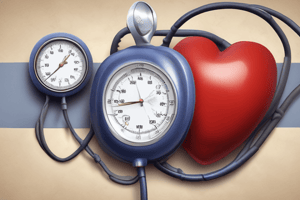Podcast
Questions and Answers
What is the main function of the peripheral chemoreceptors in regulating blood pressure?
What is the main function of the peripheral chemoreceptors in regulating blood pressure?
- To increase cardiac output and vasoconstriction in response to hypoxia and acidosis (correct)
- To have no effect on blood pressure regulation
- To both increase and decrease blood pressure depending on the stimulus
- To decrease cardiac output and vasodilation in response to hyperoxia and alkalosis
How does the capillary fluid shift mechanism help regulate blood pressure?
How does the capillary fluid shift mechanism help regulate blood pressure?
- It can both increase and decrease blood pressure by altering capillary hydrostatic pressure and fluid shifts (correct)
- It only increases blood pressure by decreasing fluid filtration and increasing reabsorption
- It has no effect on blood pressure regulation
- It only decreases blood pressure by increasing fluid filtration and decreasing reabsorption
What is the nervous connection between the peripheral chemoreceptors and the regulation of blood pressure?
What is the nervous connection between the peripheral chemoreceptors and the regulation of blood pressure?
- The aortic bodies are innervated by the 10th nerve, and the carotid bodies are innervated by the 9th nerve (correct)
- The aortic bodies are innervated by the 9th nerve, and the carotid bodies are innervated by the 10th nerve
- The peripheral chemoreceptors are not directly connected to the nervous system for blood pressure regulation
- Both the aortic and carotid bodies are innervated by the 8th nerve
What is the initial response of the peripheral chemoreceptors to a drop in blood pressure due to hemorrhage?
What is the initial response of the peripheral chemoreceptors to a drop in blood pressure due to hemorrhage?
How does the capillary fluid shift mechanism help regulate blood pressure during changes in blood volume?
How does the capillary fluid shift mechanism help regulate blood pressure during changes in blood volume?
What is the primary function of the arterial baroreceptors?
What is the primary function of the arterial baroreceptors?
Which cranial nerve carries the afferent impulses from the carotid sinus baroreceptors?
Which cranial nerve carries the afferent impulses from the carotid sinus baroreceptors?
What is the effect of decreased arterial blood pressure on the pressor area of the brainstem?
What is the effect of decreased arterial blood pressure on the pressor area of the brainstem?
What is the relationship between arterial blood pressure and the rate of discharge from the arterial baroreceptors?
What is the relationship between arterial blood pressure and the rate of discharge from the arterial baroreceptors?
What is the primary reflex pathway activated by the carotid sinus baroreceptors in response to increased arterial blood pressure?
What is the primary reflex pathway activated by the carotid sinus baroreceptors in response to increased arterial blood pressure?
Flashcards are hidden until you start studying




